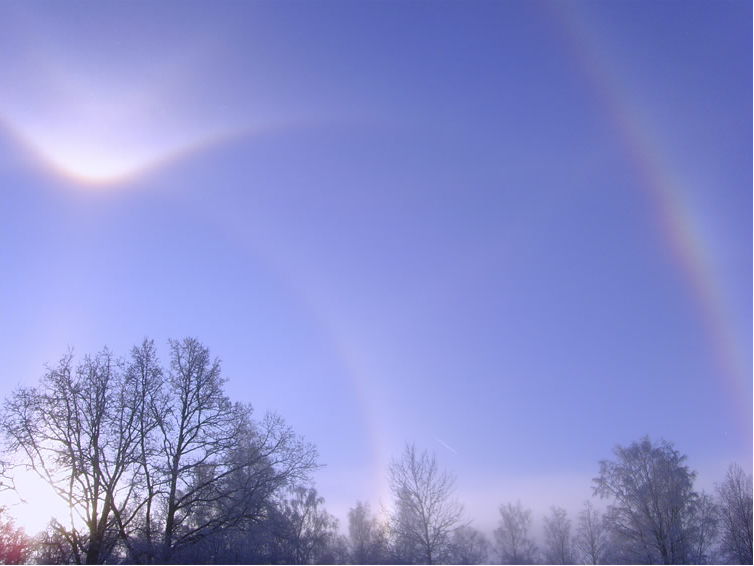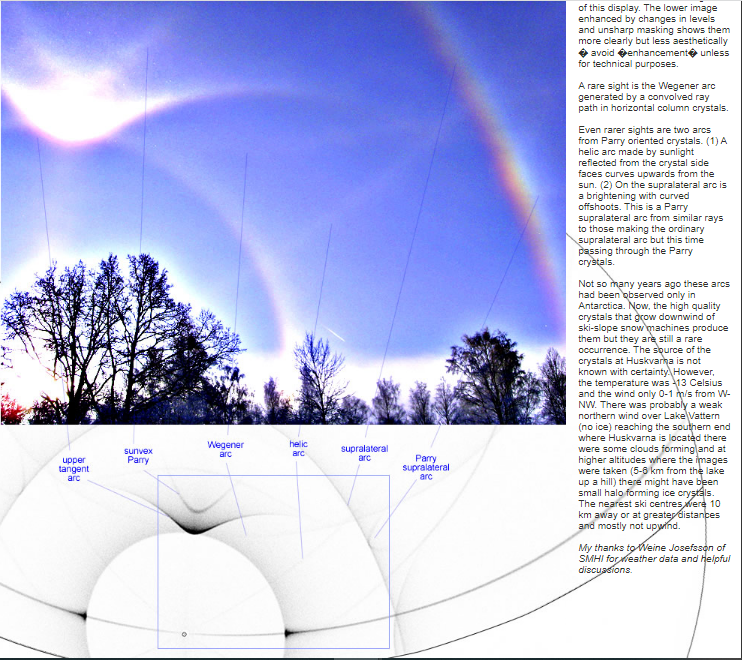Rare Halos, Sweden
Rare Halos in Sweden: A Captivating Atmospheric Phenomenon
Sweden is known for its breathtaking natural landscapes, and occasionally, it offers an even more enchanting spectacle - rare halos. These optical phenomena, caused by the interaction of light with ice crystals in the atmosphere, create a mesmerizing display of colors and shapes. One such remarkable occurrence was captured by Lotta Gustavsson on December 30, 2009, at Huskvarna, located at the southern end of Lake Vattern.
In the captivating image captured by Gustavsson, we can observe a notable diamond dust display dominated by halos from horizontal column and Parry oriented crystals. The upper left corner showcases an intense upper tangent arc, accompanied by a less common sunvex Parry arc tucked just above it. These arcs only appear at low sun elevations, and in this particular image, the sun was at an elevation of 8.7 degrees.
The image also reveals a vibrant colored arc on the right side, known as a supralateral. Unlike the more commonly observed 46-degree halo, the supralateral appears due to the purity of colors, the weakness of the inner 22-degree halo (caused by fewer randomly oriented crystals), and the strength of the tangent arc (resulting from an abundance of horizontal columns).
While these halos are undeniably captivating, the true gems of this display are the fainter arcs. By enhancing the lower image through changes in levels and unsharp masking, we can discern these arcs more clearly. However, it is important to note that such enhancements should be used sparingly and only for technical purposes.
One particularly rare sight captured in this image is the Wegener arc, generated by a convolved ray path in horizontal column crystals. This arc is seldom observed and adds an extra layer of intrigue to the overall spectacle. Even rarer still are two arcs from Parry oriented crystals. The first is a helic arc, which curves upwards from the sun and is formed by sunlight reflected from the crystal side faces. The second is a Parry supralateral arc, which appears as a brightening with curved offshoots on the supralateral arc. These arcs result from rays passing through the Parry crystals, creating a truly exceptional visual experience.
Not too long ago, such halos were primarily observed in Antarctica. However, in recent years, the high-quality crystals that form downwind of ski-slope snow machines have made it possible to witness these rare phenomena in other locations, including Sweden. Despite this, rare halos remain a rarity even in these regions, making each sighting all the more special.
While the exact source of the crystals observed in Huskvarna is not definitively known, weather data suggests that the temperature at the time was -13 degrees Celsius, with a wind speed of 0-1 m/s from the west-northwest. It is likely that a weak northern wind over Lake Vattern, without any ice cover, reached the southern end where Huskvarna is located. Additionally, there were some clouds forming at higher altitudes, approximately 5-6 km from the lake up a hill, which may have contributed to the presence of small halo-forming ice crystals. Although the nearest ski centers were located at distances of 10 km or greater, they were mostly not upwind.
The rare halo display captured by Lotta Gustavsson serves as a testament to the beauty and wonder of atmospheric optics. These natural phenomena remind us of the intricate interactions between light and ice crystals in our atmosphere, creating awe-inspiring spectacles that continue to captivate and amaze us. So, keep your eyes to the sky, for you never know when you might witness the magic of rare halos in all their splendor.

Rare Halos, Sweden
Imaged by Lotta Gustavsson December 30, 2009 at Huskvarna at the southern end of Lake Vattern. �Lotta Gustavsson, shown with permission.


A notable diamond dust display dominated by the halos from horizontal column and Parry oriented crystals.
At upper left is an intense upper tangent arc with a much less common sunvex Parry arc tucked above it. This arc only appears at low sun elevations. The sun was 8.7� here.
The coloured arc at right is a supralateral from column crystals. Why not a 46� halo? Because the colours are pure, the inner 22� halo is weak (few randomly oriented crystals that would otherwise make a 46� halo) and the tangent arc is strong (plenty of horizontal columns).
But the fainter arcs are the gems of this display. The lower image enhanced by changes in levels and unsharp masking shows them more clearly but less aesthetically � avoid �enhancement� unless for technical purposes.
A rare sight is the Wegener arc generated by a convolved ray path in horizontal column crystals.
Even rarer sights are two arcs from Parry oriented crystals. (1) A helic arc made by sunlight reflected from the crystal side faces curves upwards from the sun. (2) On the supralateral arc is a brightening with curved offshoots. This is a Parry supralateral arc from similar rays to those making the ordinary supralateral arc but this time passing through the Parry crystals.
Not so many years ago these arcs had been observed only in Antarctica. Now, the high quality crystals that grow downwind of ski-slope snow machines produce them but they are still a rare occurrence. The source of the crystals at Huskvarna is not known with certainty. However, the temperature was -13 Celsius and the wind only 0-1 m/s from W-NW. There was probably a weak northern wind over Lake Vattern (no ice) reaching the southern end where Huskvarna is located there were some clouds forming and at higher altitudes where the images were taken (5-6 km from the lake up a hill) there might have been small halo forming ice crystals. The nearest ski centres were 10 km away or at greater distances and mostly not upwind.
My thanks to Weine Josefsson of SMHI for weather data and helpful discussions.
Note: this article has been automatically converted from the old site and may not appear as intended. You can find the original article here.
Reference Atmospheric Optics
If you use any of the definitions, information, or data presented on Atmospheric Optics, please copy the link or reference below to properly credit us as the reference source. Thank you!
-
<a href="https://atoptics.co.uk/blog/rare-halos-sweden/">Rare Halos, Sweden</a>
-
"Rare Halos, Sweden". Atmospheric Optics. Accessed on April 20, 2024. https://atoptics.co.uk/blog/rare-halos-sweden/.
-
"Rare Halos, Sweden". Atmospheric Optics, https://atoptics.co.uk/blog/rare-halos-sweden/. Accessed 20 April, 2024
-
Rare Halos, Sweden. Atmospheric Optics. Retrieved from https://atoptics.co.uk/blog/rare-halos-sweden/.